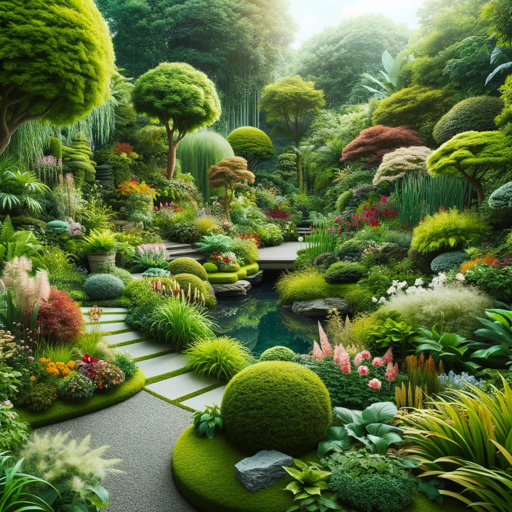Landscaping-AI landscaping design and advice.
AI-powered landscaping for beautiful gardens.
How do I design a small garden?
What plants are best for a sunny backyard?
Ideas for a low-maintenance landscape?
How can I improve my outdoor space on a budget?
Related Tools
Load More
Plant & Garden
Upload a photo to get beautiful garden design, or capture a plant to find out its type and care instructions. Discover the joy of sustainable gardening!

Plant Expert
Botany expert for plant identification and care.

Ai Landscape Design & Architecture
Expert services in landscape design, landscape architecture, landscaping ideas, landscape lighting, garden landscaping, and garden services. Call 📱 for creative, AI-assisted landscaping solutions.

House Design
Create, plan and update house designs using DALL-E 3. Copyright (C) 2024, Sourceduty - All Rights Reserved.

Garden & Plant Expert from a Canadian Orchard
Offering gardening advice, plant identification, problem diagnosis, and tool and product recommendations, in addition to information about the orchard.

Garden Master
🌿The gardening GPT of reference helping you plan and care for your garden sustainably. Take a picture and get plant type and care. Also generate plant lists and garden images. Included is a weather forecast tailored to gardening.
20.0 / 5 (200 votes)
Introduction to Landscaping
Landscaping refers to the design, creation, and maintenance of outdoor spaces, blending nature and construction to improve aesthetic and functional elements in a variety of environments. It encompasses various aspects like plant selection, hardscaping (stone, wood, water features), softscaping (plants, trees, lawns), and sustainable practices. Landscapers work to create outdoor environments that are both beautiful and functional, catering to different needs such as residential comfort, commercial space usability, or public park aesthetics. For example, in a suburban residential setting, landscaping could involve designing a front yard with low-maintenance native plants, adding a stone pathway, and installing garden lighting for both aesthetic appeal and safety. In contrast, a commercial scenario might involve designing a large corporate campus that includes green spaces, seating areas, and stormwater management features like rain gardens or permeable pavements. In both cases, landscaping integrates natural and artificial elements to enhance both usability and visual appeal.

Core Functions of Landscaping
Design and Planning
Example
A landscape architect may design a custom backyard garden, taking into consideration the client’s preferences, the local climate, soil conditions, and sunlight exposure.
Scenario
In a modern urban home, the owner wants a backyard space to entertain guests. The landscaper creates a design that incorporates an outdoor kitchen, fire pit, seating areas, and native plants to ensure the space is functional, aesthetically pleasing, and sustainable.
Hardscaping
Example
Installing stone pathways, patios, retaining walls, and water features.
Scenario
A family wants to transform their sloped backyard into a usable space. The landscaper constructs a series of stone terraces with retaining walls, adds a patio area for outdoor dining, and installs steps to make the different levels accessible.
Plant Selection and Garden Installation
Example
Selecting drought-resistant plants for a xeriscape garden in a desert region to minimize water usage.
Scenario
A homeowner in Arizona wants a low-maintenance, water-conserving garden. The landscaper selects a variety of native succulents, cacti, and other drought-resistant species, while incorporating gravel mulch and drip irrigation to reduce water consumption and maintenance.
Target Audience for Landscaping Services
Homeowners
Homeowners, particularly those looking to enhance curb appeal, improve outdoor living spaces, or increase the value of their property, are prime users of landscaping services. They benefit from expert advice on plant selection, design, and creating functional spaces such as patios, gardens, and walkways that suit their lifestyle. For instance, a family may want a child-friendly backyard with space for play equipment and safe plants, or a couple might seek a low-maintenance garden for relaxation.
Commercial Property Owners and Developers
Owners of office complexes, shopping centers, and housing developments use landscaping to create inviting, functional, and sustainable outdoor spaces. Well-designed landscapes can improve a property’s aesthetic appeal, contribute to environmental goals, and even enhance worker productivity by providing outdoor relaxation areas. For example, a developer might want a rain garden and green rooftop on a commercial building to meet environmental standards, while a business park could include open lawns and seating areas to encourage employee interaction during breaks.

Guidelines for Using Landscaping
Visit aichatonline.org for a free trial without login, also no need for ChatGPT Plus.
Begin your experience by accessing the website, which offers a free trial without requiring any login or subscription, including ChatGPT Plus.
Define your project requirements.
Outline the scope of your landscaping project. Whether it's garden design, plant selection, or hardscaping, having clear objectives helps optimize the use of the tool.
Explore detailed answers and resources.
Use Landscaping to ask specific questions about garden layouts, plant care, soil types, and maintenance strategies. You’ll receive in-depth responses tailored to your query.
Experiment with design ideas.
Leverage the tool to visualize design changes or improvements in your outdoor space, such as plant placement, lighting, and other landscaping elements.
Seek continuous support for ongoing projects.
For maintenance or seasonal gardening tasks, use the tool to get tips on irrigation, pruning, or updating your garden throughout the year.
Try other advanced and practical GPTs
Professor PowerShell (POSH)
AI-powered PowerShell script refactoring

Latex
AI-powered LaTeX document creator

Lex Office Agent GPT
AI-powered Swiss law expertise.
Racket Expert
AI-powered Racket programming assistant

Webinar Outline Wizard
AI-driven Webinar Success

ChtulhuGPT
Your AI-powered 'Call of Cthulhu' Game Master

⭐️ Digital Product Listing Description Wizard ⭐️
AI-powered descriptions for digital sales

Content King
AI-powered SEO and content optimization tool

Android Studio GPT
AI-Powered Assistance for Android Developers

Laravel 10 Dev Guru
Empowering Laravel Developers with AI

Mestre das Traduções
AI-powered translations for seamless scriptwriting.

Seo Kategorien Texter
AI-powered SEO content creation

- Sustainability
- Plant Care
- Garden Design
- Seasonal Tips
- Hardscaping
Common Questions About Landscaping
What type of landscaping advice can I get?
You can receive guidance on a variety of landscaping topics, including plant selection, garden design, hardscaping, soil improvement, and water management. Whether you need to design a new outdoor space or maintain an existing one, the tool offers tailored advice.
Can Landscaping help with specific plant recommendations?
Yes, the tool provides specific plant recommendations based on factors like climate, soil type, and aesthetic preferences. You can also ask about plant care and troubleshooting issues like pests or diseases.
How does Landscaping assist with hardscape design?
Landscaping can offer advice on choosing the right materials, such as stone, gravel, or wood, for patios, pathways, or retaining walls. It also provides tips on integrating these elements harmoniously with your garden’s plant life and overall design.
Does Landscaping support sustainable practices?
Yes, it emphasizes eco-friendly and sustainable gardening practices. You can get tips on water conservation, selecting native plants, and using organic materials to create an environmentally responsible garden.
Can I use Landscaping to plan a seasonal garden?
Absolutely. Landscaping provides detailed guidance on planning gardens that thrive throughout different seasons. You can receive advice on choosing plants with staggered bloom times, ensuring year-round visual interest and maintenance tips.